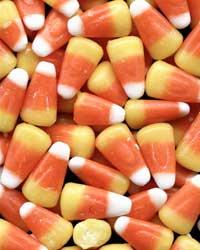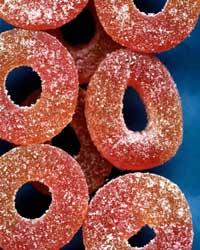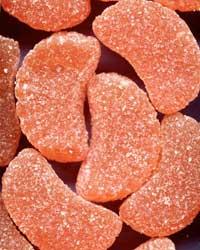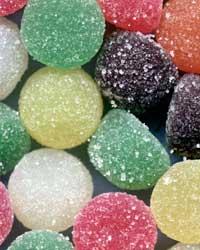Sweets and natural but harmful to health

The first gelatin sweet was made in 1920 in Germany, but few years have been enough to expand and expand the market with all colors and shapes. Hans Riegel and his wife Gertrud are the founders of these candies, but probably would never have imagined that the candy market would evolve so much. Currently, in Spain, for example, more than 80,000 jelly candies are produced annually, with a turnover of 40,000 million pesetas. The truth is that you only have to see the pastry shops that are usually around the cinemas to realize that they are your liking, but another thing is that, knowing the ingredients of these candies, they can have an effect on health.
Natural components natural components
The first jelly candies were transparent and bright. Today, in addition to colors, sugars, sparkling ones, fruits, licorice, etc. They are carried out. It is evident that to obtain these flavors and appearances different products are used, but the basic mass is constituted by gelatin of food or gelatinants obtained from plants.

Still today, the first ingredient most used for the rubber texture is gelatin food. This gelatin is a jelly that is extracted from the skin and bones of animals suitable for human feeding and that, in addition to the candy, is very used in the pharmaceutical industry to produce, among other things, a capsule that surrounds many medicines. The collagen present in these first ingredients is used for the production of gelatin. 84-90% of gelatin are proteins, 12-8% water and 2-4% mineral salts. Proteins are amino acid molecules and the main amino acids that make up gelatin are hydroxyproline, hydroxylasin and arginine. Therefore, the celler has no glycous.
But not only of the skins and bones of the animals, but also of the plants and algae, the component that gives the candies a rubber texture. Some of the ingredients obtained from the bark of plants and fruits are pectin, gum arabic and agar-agar. The first is obtained mainly from citrus, the second of the trees of the genus Acacia and the third is a compound of the walls of the red algae cells. All of them dissolve in hot water, but as the water cools down, the mixture becomes gelatinous.

Surprisingly, the jelatín that gives rubber texture to the candies does not have any glycerides, but the makers of candies know how to fill that gap. In fact, although the base is gelatin, they are added to the additive candies that provide sugar, dyes and flavor. As a result, a third of the candies is cooked.
As for the colors and flavors, substances are used from the fruits and plants used in ice cream and, in general, in pastry. Finally, non-sugar-coated rubber candies are also added vegetable fat to prevent them from sticking in the packages.
Is it harmful to health?
The answer to this question is probably not to the liking of children and pastries, but it is harmful to health to eat candies every day. In addition, the new research confirms what was already considered good.

The research carried out to date focused on the relationship between candies and weight. It was said that eating many candies fat. This expression is not erroneous and has a simple explanation. Glucids can be of quick assimilation (candies) and of slow assimilation (cereal). The glucides of rapid assimilation are like "canics" and pass from the intestine to the blood without problems. Slow assimilations, on the other hand, are united with each other and the organism takes longer to break the unions and assimilate the glucides. With the latter the organism manages to regulate with ease the amount of sugar in the blood, the glycemia.
The amount of sugar is 0.8 to 1 mg per liter of blood. On the contrary, the glucides of rapid assimilation quickly reach the blood and the organism has no time to regulate it. As a result, glycemia rises and stored sugars… that is, kilos!

But the candies have another influence, not only provoke the increase of the kilos, but also of the blood pressure, and do not think that for that you have to eat for kilos! In the words of Helga Sigurjonsdottir, a researcher at the Sahlgrenska University in Sweden, "we must review the relationship between candies and hypertension, since the effect is greater than expected". It is enough to eat between 2 and 4 weeks every day 50 g of licorice so that the increase in blood pressure is considerable.
On the other hand, the influence of daily consumption of candies on the hormone of cortisol has also been shown. Cortisol is the most active of natural hormones and the body produces it mainly in the morning. Cortisol causes the destruction of the protides, the increase of sugars in the blood, and the retention of salts in the kidneys. All these tasks of cortisol are important, but if we eat too much candies, the cortisol does not dissolve and, among other things, it keeps too much salt in the kidneys.

Before, the effect of cortisol on blood pressure was unknown, but as research advances, it has been observed that the abuse of candies blocks the enzyme that causes the metabolism of cortisol. According to the researcher at the University of Birmingham, Paul Stewart, "we must take into account and continue investigating this enzyme because hypertension is not a problem of a few".
They say that elections become easier to know. The next time you go through the candy shop, are you going to buy candies?
Published in 7K
Buletina
Bidali zure helbide elektronikoa eta jaso asteroko buletina zure sarrera-ontzian











